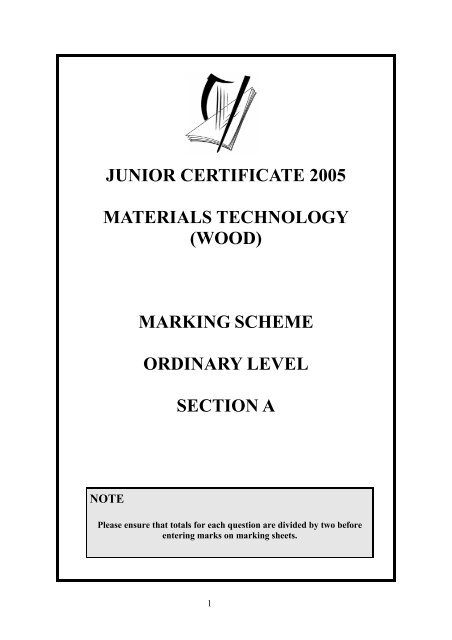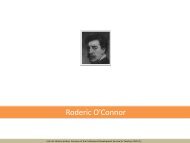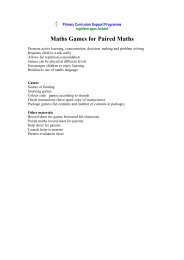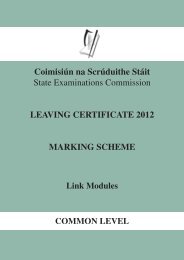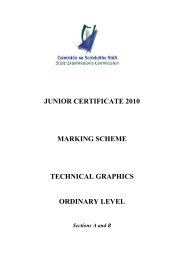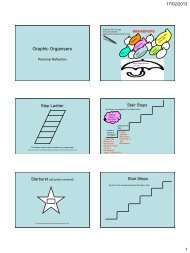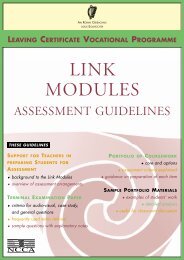Marking Scheme - Examinations.ie
Marking Scheme - Examinations.ie
Marking Scheme - Examinations.ie
You also want an ePaper? Increase the reach of your titles
YUMPU automatically turns print PDFs into web optimized ePapers that Google loves.
JUNIOR CERTIFICATE 2005MATERIALS TECHNOLOGY(WOOD)MARKING SCHEMEORDINARY LEVELSECTION ANOTEPlease ensure that totals for each question are divided by two beforeentering marks on marking sheets.1
SECTION A - Short AnswersMark all questions, select the best 16 questionsThis section is marked out of 80 marks.Divide the final mark by 2 on completion of marking.A mark must be shown under each heading, including zero.Q. SOLUTION MARKS DIAGRAM (IF ANY)1. Countersunk head 5 marks.2a.OR2b.Name: Sliding bevelUse: Used like a try square.Used to help draw lines at aset angle across the wood.Name: Claw HammerUse: For driving nails and forpulling nails.Eitherone,3 marks.Both5 marks.OREitherone,3 marks.Both5 marks.3.Any one2 marks.Any two4 marks.All three5 marks.TopSideEnd4.Name: Tower bolt, drawbolt, barrel bolt.Use:Locking doors from theinside.Securing one door of doubledoors.Eitherone,3 marks.Both5 marks.2
Q. SOLUTION MARKS DIAGRAM (IF ANY)Either one,5.A: Oak3 marks.B: Horse ChestnutBoth5 marks.AB6. Scroll saw 5 Marks7.8.Lathe workDrillingGrindingUsing the routerSprayingEtc.The long plane will plane thehumps and skip the hollowsuntil the entire surface iseven. The shorter the planethe more likely it is to followthe existing curvature of thewood.Any one,3 marks.Two rules,5 marks.5 marks9. Pith 5 marksA10.11.Norway Spruce — SoftwoodAsh ——–——— HardwoodDouglas Fir ——– SoftwoodHorse Chestnut— HardwoodScots Pine ——— SoftwoodThis allows air to circulatefreely under the stack.Prevents the bottom boardsfrom soaking moisture upfrom the ground.1 markper correctanswer.5 marks.3
Q. SOLUTION MARKS DIAGRAM (IF ANY)12. Dowel Joint. 5 marks.13.A: HeadstockB: BedEither one,3 marks.Both5 marks.AB14. Coping saw.5 marks.15.Drill slowly.Pilot hole.Support well underneath.Masking tape on the topand bottom.Any one5 marks16. V-Tool 5 marks17. Brown 5 marksA4
Q. SOLUTION MARKS DIAGRAM (IF ANY)18. 5 marks.19. Skew nailing.Dovetail nailing.5 marks.20. Text. 5 marks.NoteSECTION ADivide final mark by 2 on completion of marking of this section5
JUNIOR CERTIFICATE 2005MATERIALS TECHNOLOGY(WOOD)MARKING SCHEMEORDINARY LEVELSECTION BNOTEPlease ensure that totals for each question are divided by TWO beforeentering marks on marking sheets.6
SECTION BMark for best three questions.This section is marked out of 120 marks.Divide the final mark by 2 on completion of markingQ. SKETCHES NOTES MARKS1(i)1(ii)The marking out and workingof the mortise is bestdone before the plane bodyis shaped.Once marked the slot may bechopped out using a mortisechisel and mallet.Work to a depth of half wayand then work through fromthe other side.The waste wood could be removedby drilling a ser<strong>ie</strong>s ofholes along the length of theslot and tidying the remainingwaste away using achisel. Again work is carr<strong>ie</strong>dout to a depth of about halfway and repeated from theother side.The waste on the semicircularends is first removedusing a coping saw, scrollsaw etc. Cut to the wasteside of the lines.The roughness left by thesaw can now be smoothenedby using a spokeshave, raspetc. Work from the sides ofthe wing towards the end ofNotes andsketches16 marks.Notes onlyorsketchesonly12 marks.Notes andsketches12 marks.Notes onlyorsketchesonly9 marks.7
Q. SKETCHES NOTES MARKS1(ii)the wing.The wing ends can then besanded using sandpaper anda sanding block. Start withmedium paper and thenmove to smooth paper.Any three tools used in thisprocess.Coping saw, scroll saw, bandsaw, tenon saw, etc.Spokeshave, rasp, surform,chisel, etc.2 markseach.1(iii)FinishNon-toxic paintOilVarnishReasons for choiceTwo reasons to support thechoice of finish.Finish2 marks.Two reasonsfor choice offinish2 markseach.8
Q. SKETCHES NOTES MARKS2(i)(a) Overall height4(b)(b) Overall width4(a)(c) Shelf4(d)(d) Dowel4(c)ELEVATION(e) Back rail4(b)2(ii)(a) Overall height4(c)(b) Overall width4(d)(a)(c) Corner removed4END VIEW(d) Centre for hole22(iii)DIMENSIONSONE mark for each correctdimension (1 mark×4)4ARROWHEADSTWO marks for correctarrows29
Q. SKETCHES NOTES MARKS3(i)3(ii)3(iii)Manufactured boardsPlywoodHardboardM.D.F.BlockboardLaminboardEtc.Description of the manufactureof one of these.A solid timber lip p<strong>ie</strong>ce canbe attached to the edge.A specially shaped metalstrip can be fixed to the edgewith screws.Iron on edging can be used.The edge can be veneered.Sheets come in large widths.Manufactured boards have auniform thickness.Sheets are very stable theydo not warp, shrink and twistlike solid wood.Thin sheets have goodstrength.Consistent quality fromsheet to sheet.No defects.Surfaces are usually smoothand flat.Can be worked into manyshapes without having toworry about short grain.Etc.Any two2 markseachNotes andsketches9 marks.Notes only orsketches only6 marks.Notes andsketches12 marks.Notes only orsketches only9 marks.Threeadvantages5 markseach.10
Q. SKETCHES NOTES MARKS4A(i)Join the corners /diagonals to find thecentre of the wood.Draw a circle on the endswith a compass.Mark out the corners thatwill be removed. Whenthese are removed it willreduce the knocking andvibration when turninginitially.Plane the corners off toform a roughly octagonalshape. The p<strong>ie</strong>ce is nowready for mounting on thelathe.3 steps5 markseach.4A(ii)Roughing gougeSpindle gougeParting toolSkew chiselSquare end scrapperCurved scrapperEtc.Diagrams of two turningtools.Twonames2 markseach.Twodiagrams3 markseach.Br<strong>ie</strong>f description of whateach of the two sketchedturning tools are used for.Twodescriptions2 markseach.11
Q. SKETCHES NOTES MARKS4A(iii)Turned spigotMortise and tenonHole and loose dowelOne methodof jointingthe stem andbase11 marks.4B(i)Glue and screwMethod 1The paper with thedrawing on it should becarefully taped onto thewood with two p<strong>ie</strong>ces oftape. A sheet of carbonpaper may now be placedbetween the wood and thedrawing. You now traceover the original drawingwith a pen or pencilensuring that no line ismissed. Once the sheetsare removed a print of thepicture will have been left.Method 2The p<strong>ie</strong>ce of paper withthe drawing could be fixeddown to the wood using alight adhesive. In order tocarve the shapes you cannow carve through thepaper into the wood beneath.6 marks.Notes andsketches16 marks.Notes onlyorsketchesonly12 marks.12
4B(i)Cont.4B(ii)Method 3The paper with the drawingis fixed to the wood usingtape. By tracing over thedrawing and leaningheavily on the pen/pencilan imprint will be made onthe wood beneath. Thisimprint can be traced overonce the sheet is removed.As an alternative acompass could be used tomark the wood through thepaper. When the paper isremoved the dots can bejoined to form the picture.NameV-toolVeinerCarving gougeDiagram2 marks.10 marks.4B(iii)The project would besanded using sandpaperand a sanding block.Use rough sandpaper first,if necessary, then move tomedium sandpaper thensmooth.Dust down the project.Apply the first coat ofvarnish. Use a brush andapply a light coat.When dry sand lightly usingwire wool and dustdown.Repeat for coats two andthree.12 marks.13
Q. SKETCHES NOTES MARKS5(i)5(ii)The lid of a treasure chestwould not be flat butwould have a curved top.Strips of metal such asbrass could be added togive the appearance of reinforcingon the treasurechest.A large hasp lock with apadlock would add to thelook of good security.Reinforcing the box cornerswith angle plates.Add an old rusty handleon the lid.Etc.Hand grips could beformed by drilling a largediameter hole rightthrough the side of thebox at either end of a slot.The waste between thetwo holes would be cutaway using a scroll saw,electric jigsaw, copingsaw etc.This slot should besmoothened carefullyusing a rasp andsandpaper.An alternative would beto form a handle by shapinga trench part waythrough the side. A routercould be used to removethe waste.A groove could be madeusing a tenon saw andchiselNotes andsketches12 marks.Notes onlyorsketchesonly9 marks.Notes andsketches18 marks.Notes onlyorsketchesonly14 marks.14
Q. SKETCHES NOTES MARKS5(iii)CarvingSome rel<strong>ie</strong>f carving on thetop and sides.Chip carving to formsymmetrical patterns onthe lid and sides.IronmongeryBy adding a decorativelock, handles, cornerbrackets.Any twoways5 markseach.VeneeringThe whole box could beveneered. Cross bandingor inlays could be added.Motifs could be insertedinto the top, front andsides.PaintingThe box could be paintedwith patterns and designs.Please ensure that totals are divided by two before enteringmarks on marking sheets15


